With the trip rearranged for a week later due to the UK being unable to cope with a little bit of snow, we eventually made it to Belfast this weekend gone. A plan was hatched a few months ago over drinks with workmates that we should go on a weekend break before Bhupesh’s visa expired & he had to go back to India. It may be the middle of winter, but I’m hardly going to let such a trifling matter get in the way of a trip somewhere new.
With all of last year’s trips under my belt, somehow it fell to me to organise everything – perhaps I was the only one motivated enough to do anything on the planning side. It was great to have friends along for a trip for a change, but organising it all and making sure everyone is enjoying themselves (I’m pretty sure most don’t share my love of history) while still trying to make sure I get to do the things I want to was something I was not used to. When the accommodation rebooking fell apart on the morning of our departure, I was not enjoying being sole organiser; but plenty of emails, phone calls and not small expense sorted that out eventually. In the end, I’m sure no one had a bad weekend, I got to see most of what I wanted and managed to get sufficient time to myself (three’s a crowd & all that).
Apart from the last minute hiccup, airbnb worked out well again – where else can you rent a three bedroom house for forty quid a night? The neighbourhood in South Belfast was pretty grim, but as always I found plenty of interest – and taxis were cheap & prompt.
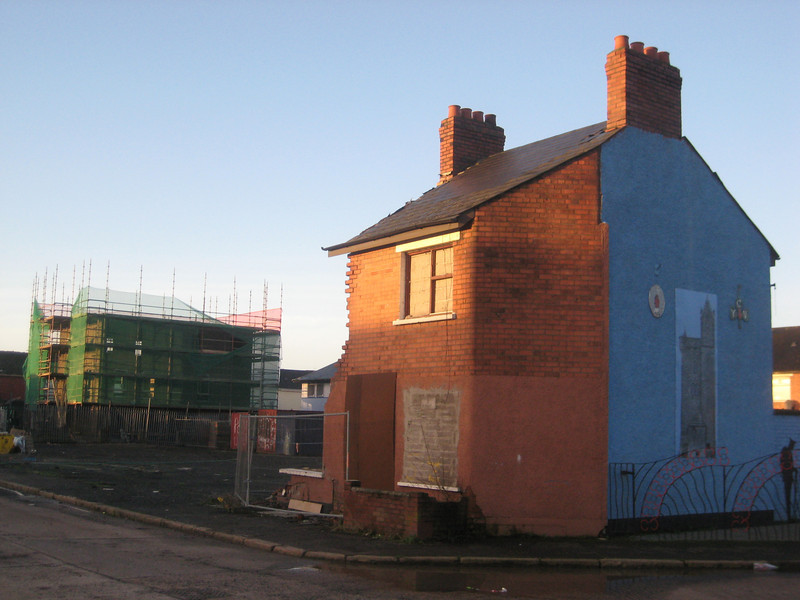 All that was left standing of the terrace across from the front door – I suspect because this house (the blue bit) had some sort of memorial to a fallen soldier
All that was left standing of the terrace across from the front door – I suspect because this house (the blue bit) had some sort of memorial to a fallen soldier
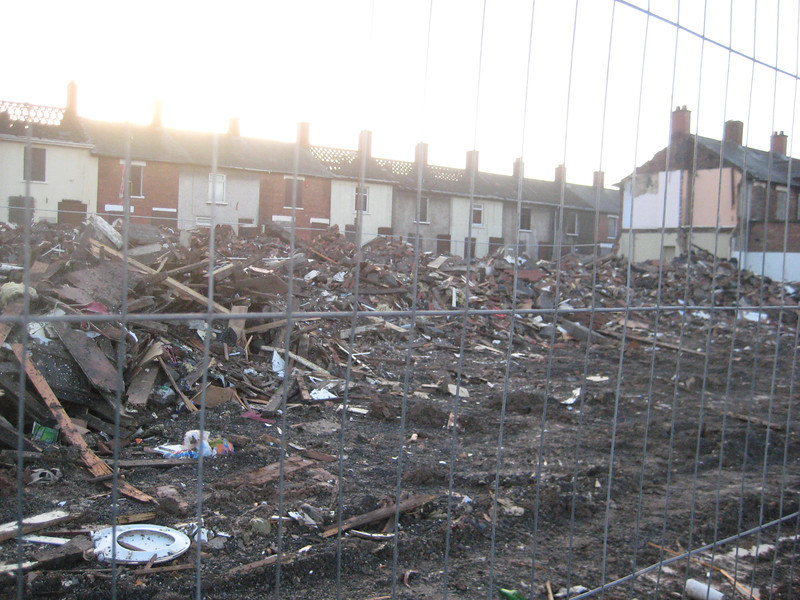 It didn’t get much better across the next street – demolition and breeze-block windowed houses, classy
It didn’t get much better across the next street – demolition and breeze-block windowed houses, classy
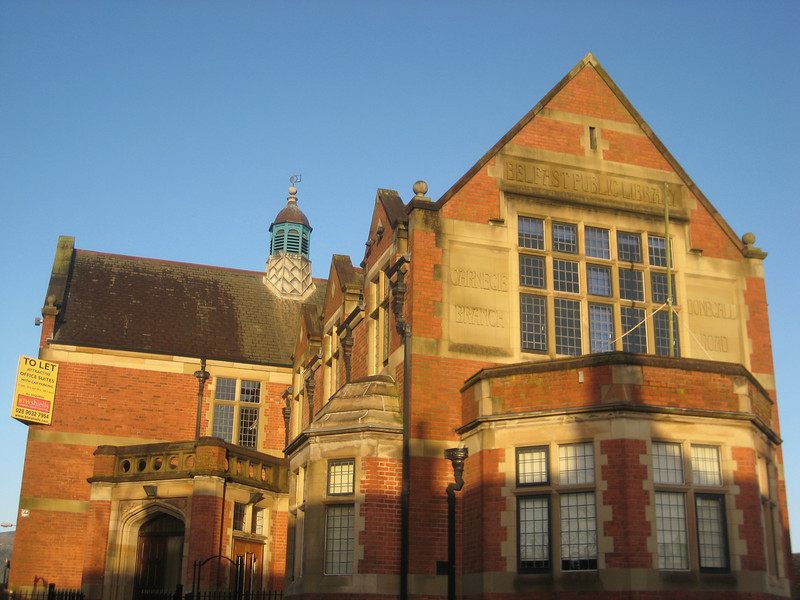 An old library on the walk to catch the day-trip coach
An old library on the walk to catch the day-trip coach
The recommended activity for the day was a trip up the coast to see the Giant’s Causeway, so that what I managed to convince all was a good idea. The day dawned bright & cool, but the clouds soon rolled in. Our driver/guide for day was recovering from illness & seemed determined to drag us all down with him as he had the air-con continually chilling us for the first few hours – I’ve never seen so many people on a modern coach still wearing winter coats, beanies & gloves (it was quite a contrast to the infamous roach-coach).
We wound our way up the coast road with an informative commentary that never seemed to stop – I’m unsure just how many times I heard the phrase “there’s another little piece of useless information for you”, it’s a pity I’ve forgotten most of it, as it was truly useless. Not to worry – the scenery was pretty and there still a dusting of snow around. Our first proper stop was at the rope bridge of Carrick-a-Rede, which was a bit of a walk from the parking lot. Graciela by now had developed a sore throat & was not keen on an exposed walk, so I headed off by myself into the bracing wind along the top of the cliffs. There’s been a bridge over to the little island for over three hundred years, mostly for fisherman to get across to collect large salmon catches – but that has dwindled now & it is mostly tourists trip-trapping over the plummet to the sea below.
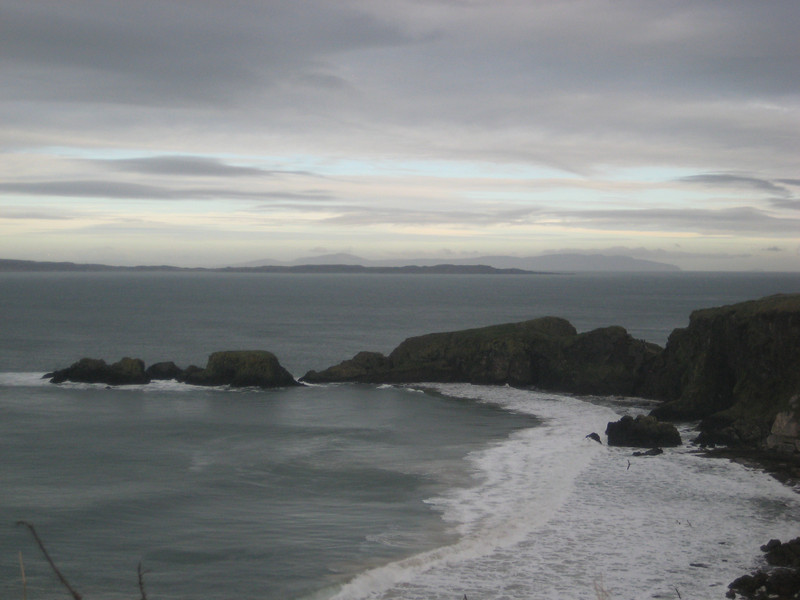
All I could think of was the Bridge of Death and the Gorge of Eternal Peril (Oh, whacko) and making sure I got the five questions, three questions, correct. Convincing myself that my favourite colour is indeed still green and reassured by the bridge-keeper from the National Trust not looking a bit like the Old Man from Scene 24, I made it across safely. There wasn’t too much to see on the island itself, but the view along the cliffs was nice & I could easily look over to the Mull of Kintyre (where I was with Mum & Dad but four and a half years ago). The weather closed in again & started liquid-sunshining (raining) on me as I walked briskly back – it was a really pleasant hour out of the coach along beautiful coast.
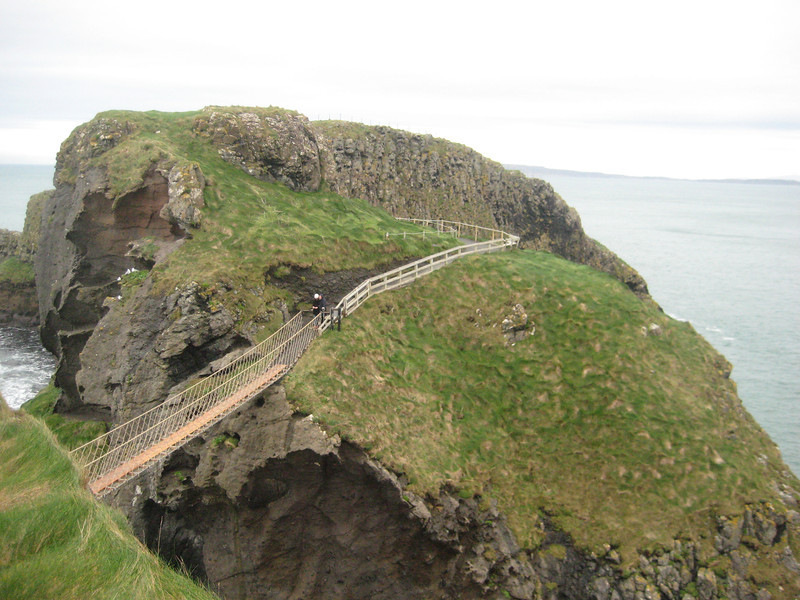
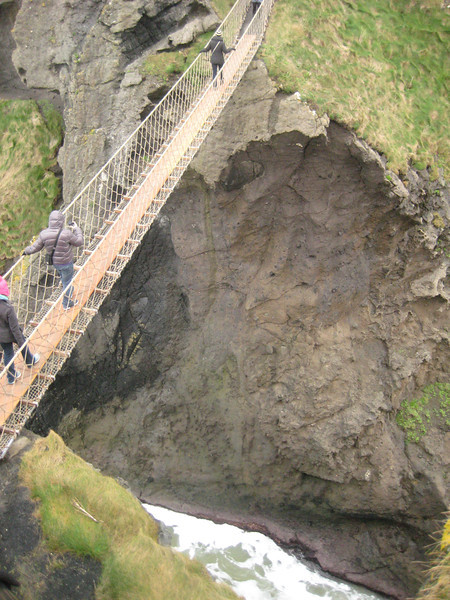
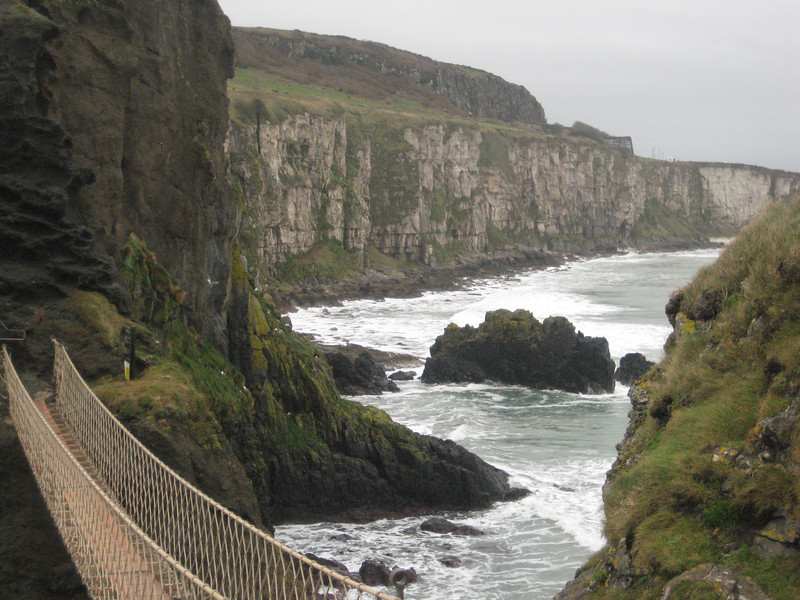
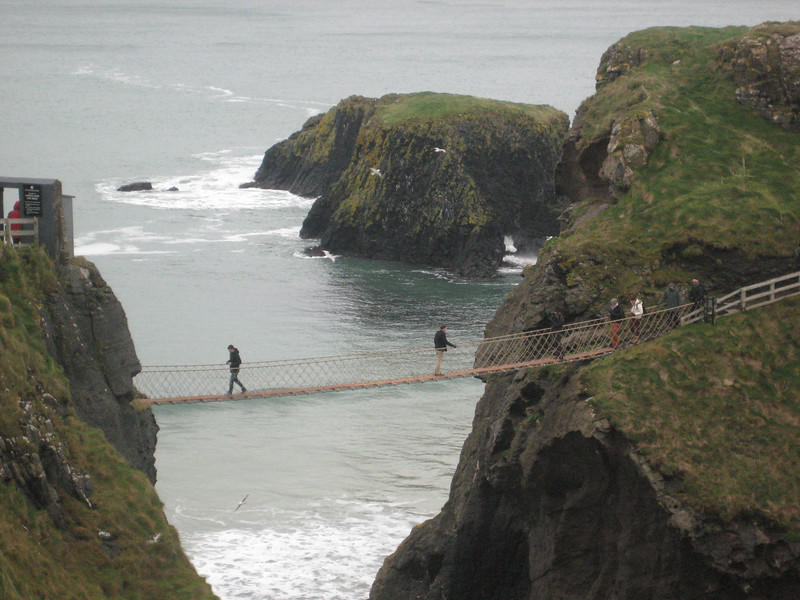
Just down the road was the UNESCO World Heritage site of Giant’s Causeway, which I was keen to see as on the trip with Mum & Dad mentioned above we went to Staffa (not far away, but over off the coast of Scotland) and saw similar basalt columns. It managed to stop raining for the walk down to the sea & we had a good hour or so mucking around on the large, wet, slippery regular paving stones – the tessellation results from the cooling of the basalt after a volcanic eruption.
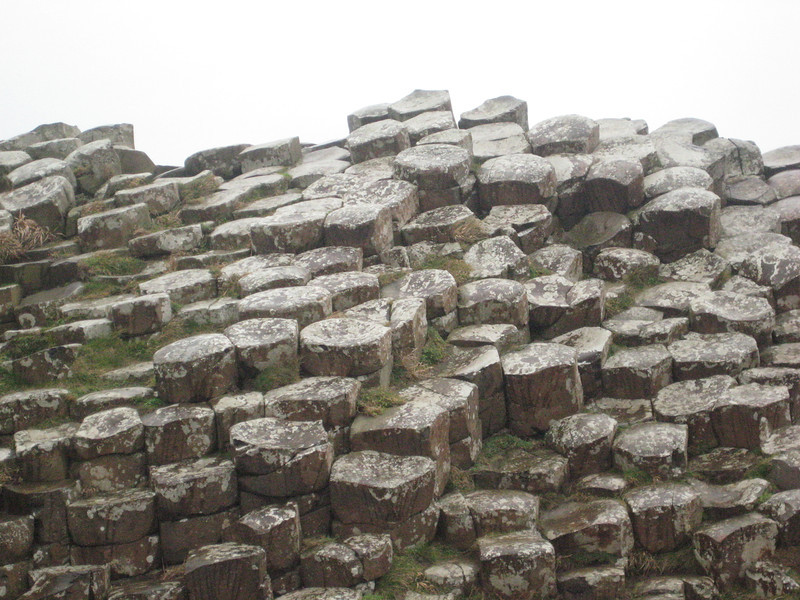
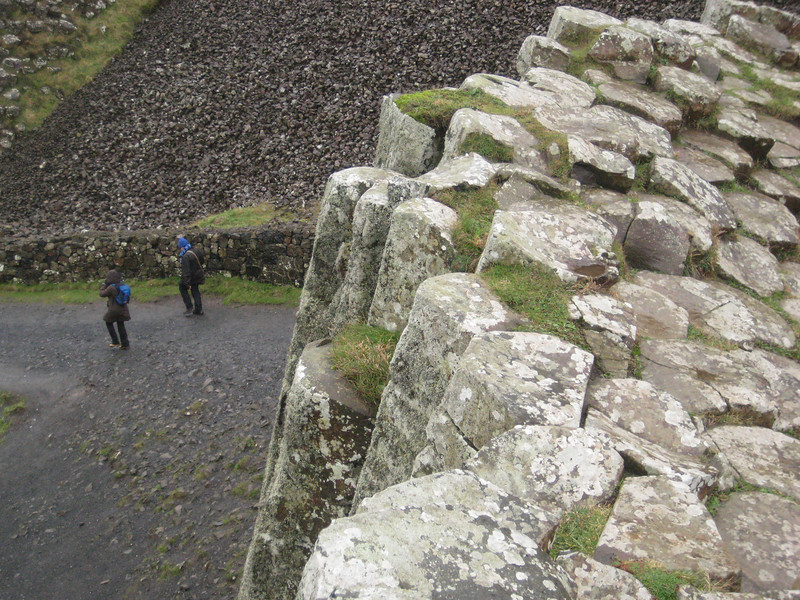 Some of the steps suddenly dropped off a few metres – probably good not to get blown over there
Some of the steps suddenly dropped off a few metres – probably good not to get blown over there
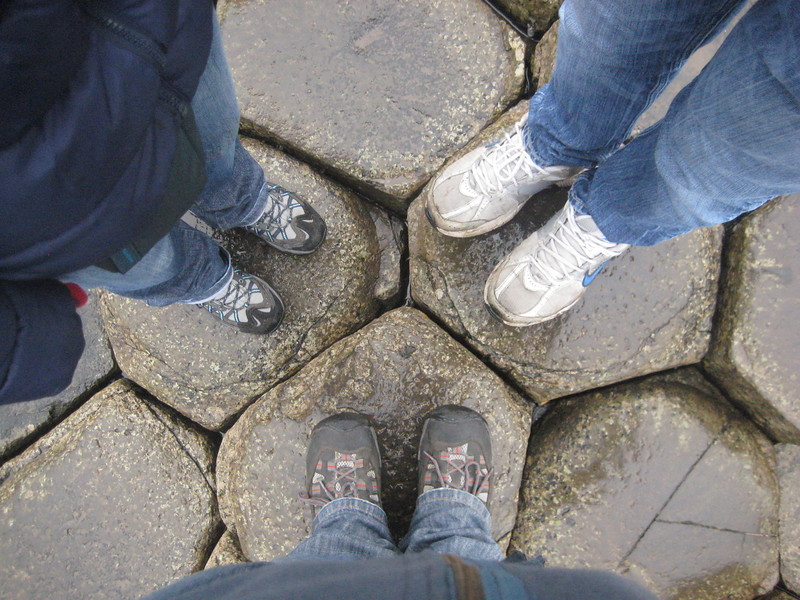
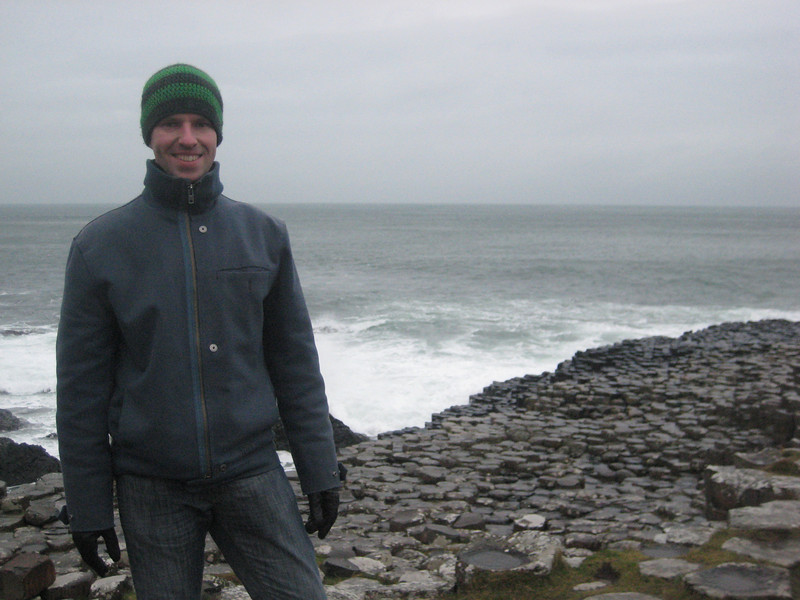 Other people to take photos of me – hoorah!
Other people to take photos of me – hoorah!
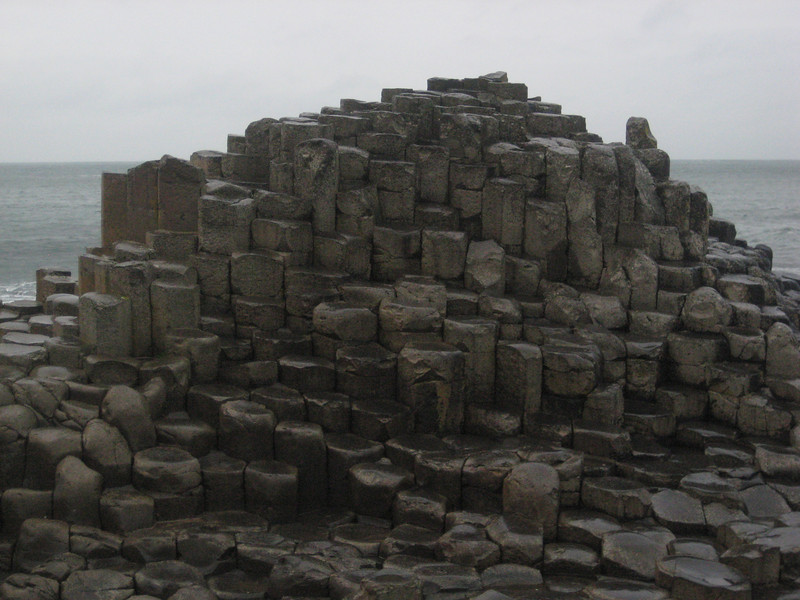
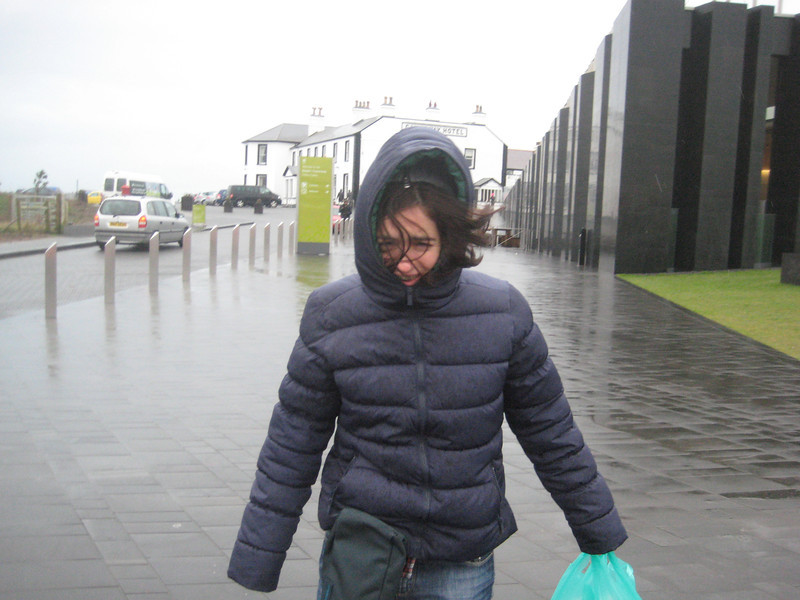 The wind may have got up a bit more
The wind may have got up a bit more
It was a quiet & quicker drive back to Belfast – it’s always surprisingly tiring work sitting on & getting in & out of a coach all day. We stocked up on breakfast supplies (potato bread is a thing of Irish genius – I bought extra to bring some back home) before warming up & heading out for a night on the town. Belfast was extremely busy for a mid-winter Saturday, it took us quite some time to find a table to eat at in the Cathedral Quarter. After which I was reminded how tedious I usually find nightclubs – on the upside, the pint of Guinness was better than the one from the night before. Oh yeah, by now Graciela had all but completely lost her voice so while that was amusing on a superficial level it did somewhat kill the joviality of the night.
Sunday morning was a bit lazier, but I managed to get everyone out the door before noon – so I counted that as a win for not wasting too much of the day! We pottered around City Hall (no Union flag flying, odd that) as nothing much opens in Northern Ireland before one o’clock on a Sunday. The others were intent on shopping, I was more interested in eating – so I went & found a nice lunch by myself before we all headed out to the recent (last year) Titanic Belfast museum.
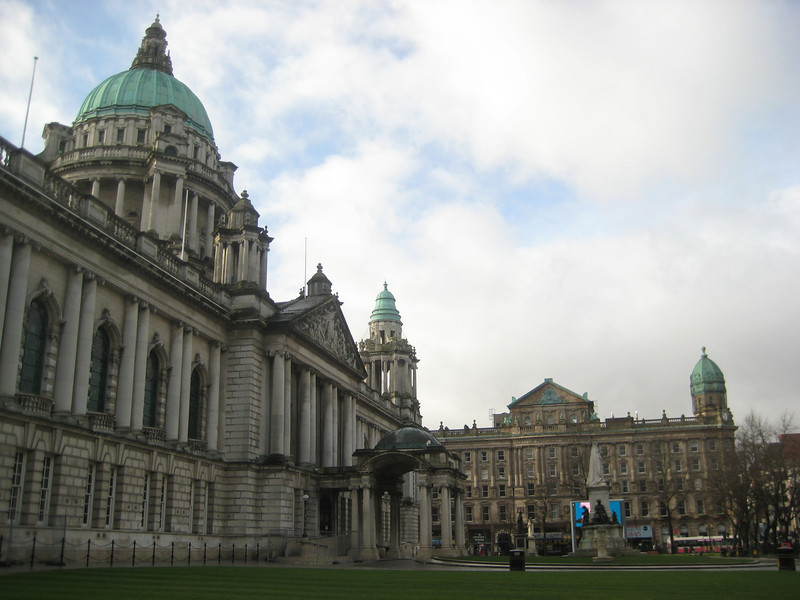
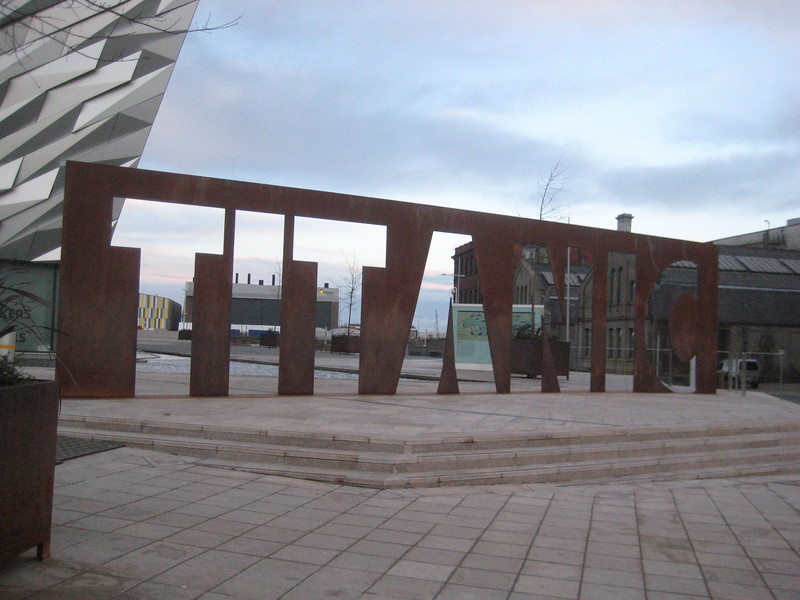
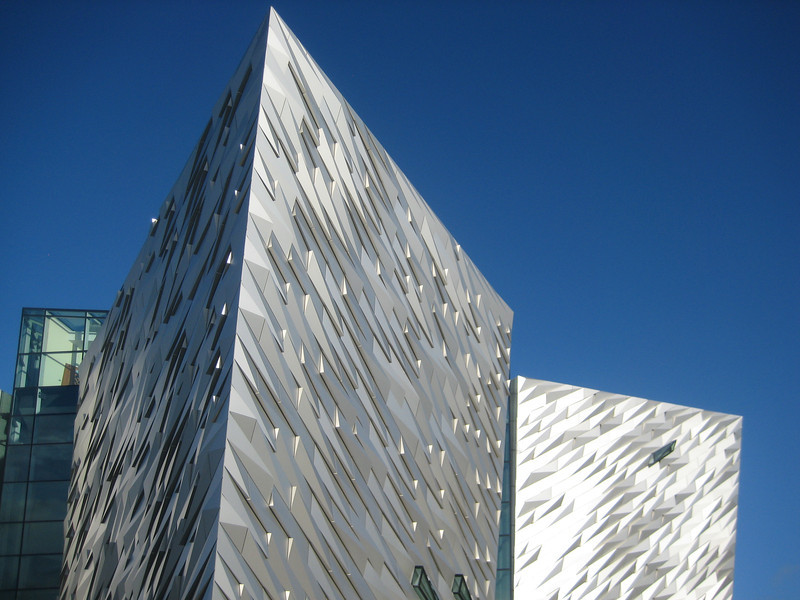 It’s a striking building
It’s a striking building
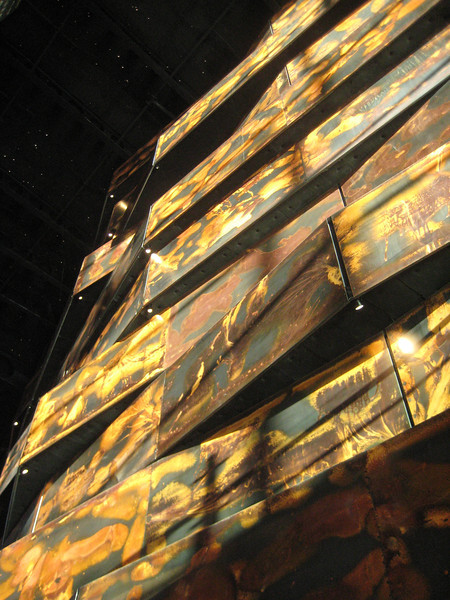 And there’s a feature wall of steel slab, which of course made me happy
And there’s a feature wall of steel slab, which of course made me happy
The museum is very well done & worth the entry fee. There’s a good split between how Titanic was built (shipbuilding is a large part of Belfast’s very proud industrial heritage), what the ship itself was like and, of course (the bit that was in the back of one’s mind throughout the rest of the exhibit), the disastrous sinking and loss of life. There was also plenty about Southampton, another proud maritime city, so I really must go and check out some of the local museums when I’ve got spare time at home.
Not sure how I’ve managed to write so much about a relatively quiet weekend (I definitely did a lot less walking & saw less than if I’d been by myself), but it was a good one & I’m glad it all worked out in the end.
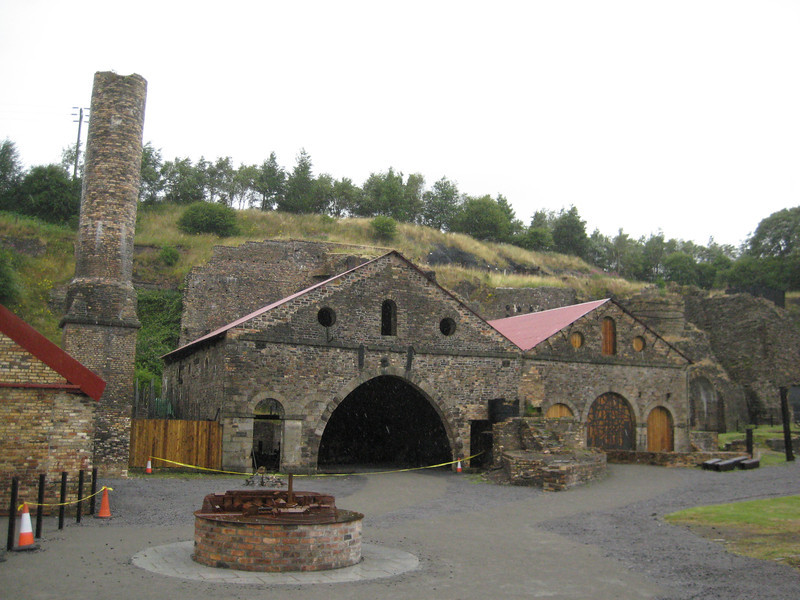
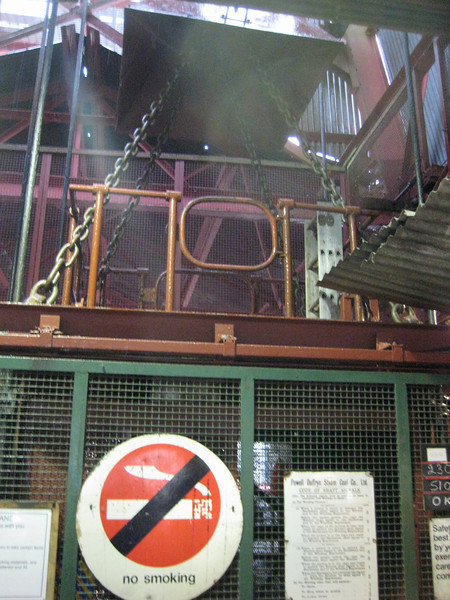
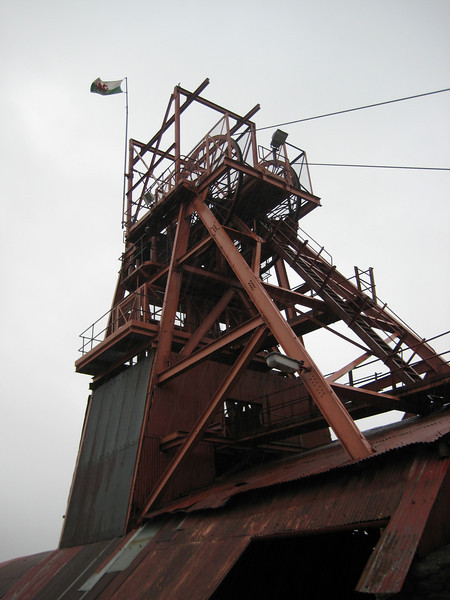
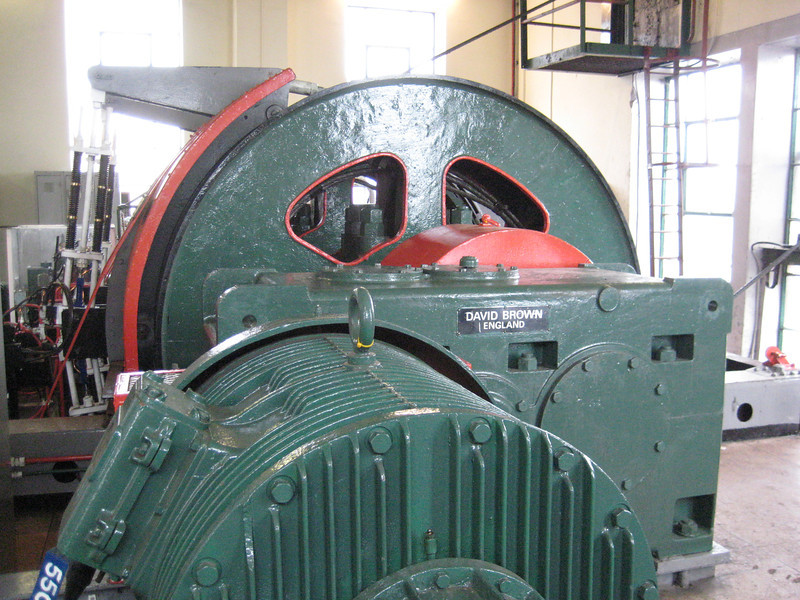
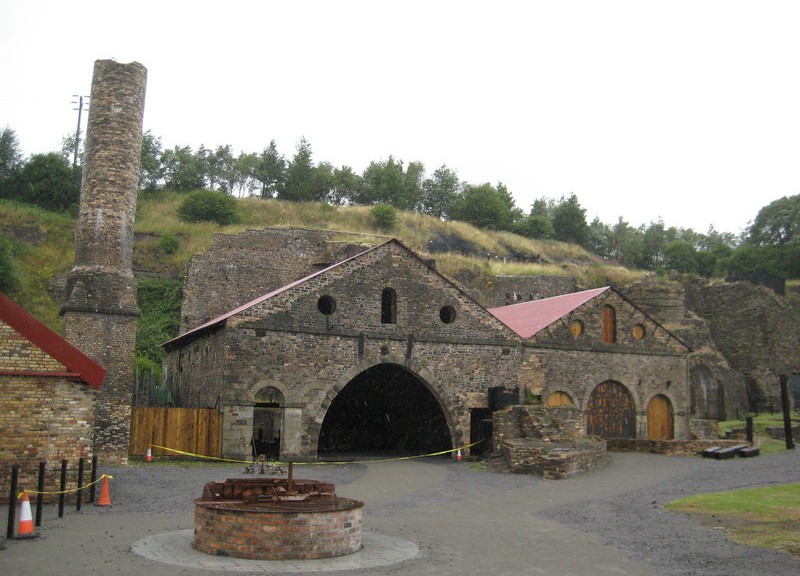
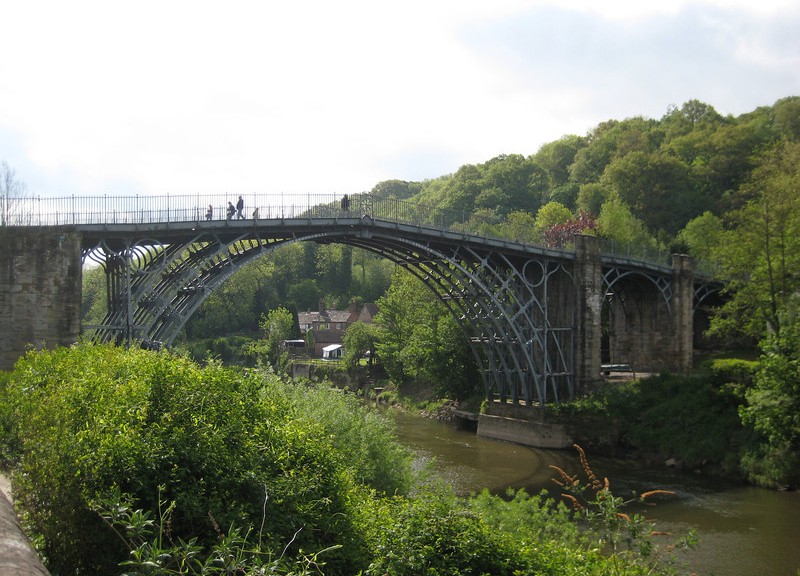
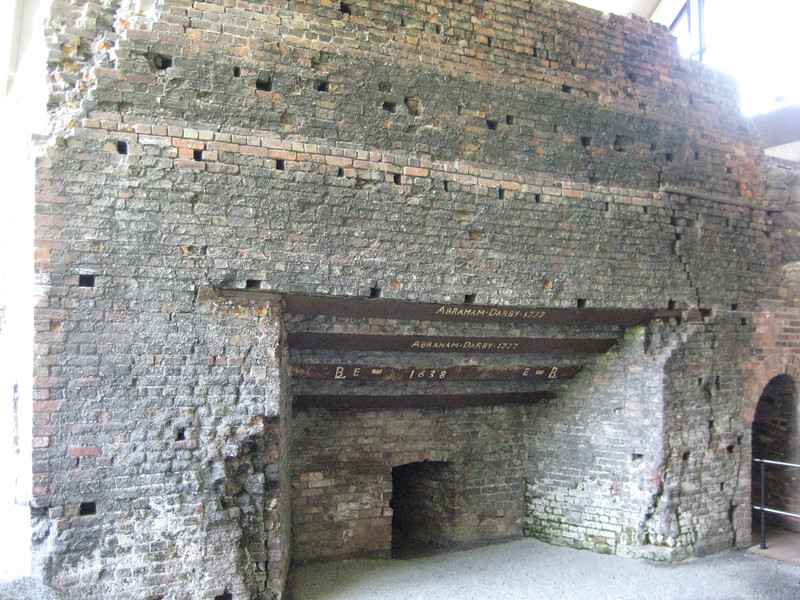 The hearth of the Old Furnace – that first used with coke.
The hearth of the Old Furnace – that first used with coke.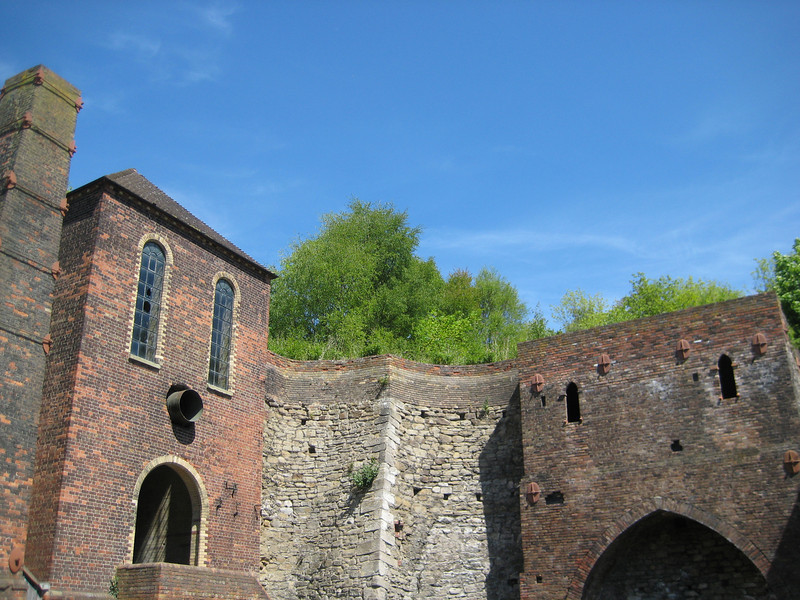 An engine house on the left & charging floor up on the right.
An engine house on the left & charging floor up on the right.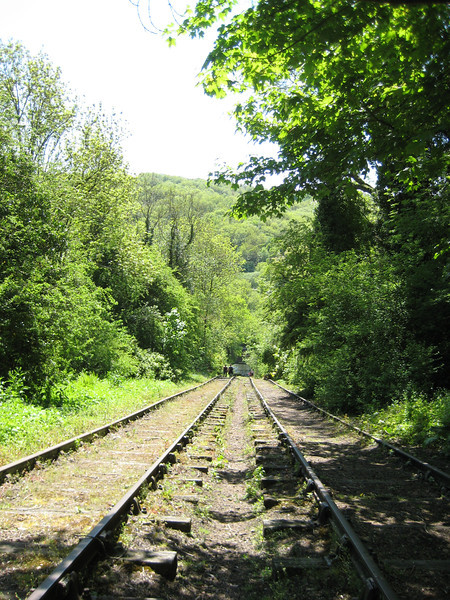 Incline plane (two sets of rails on a steep hill)
Incline plane (two sets of rails on a steep hill)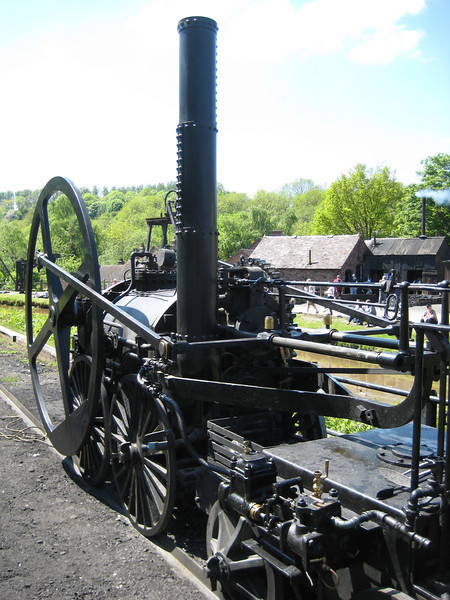 A working replica of Trevithick’s locomotive
A working replica of Trevithick’s locomotive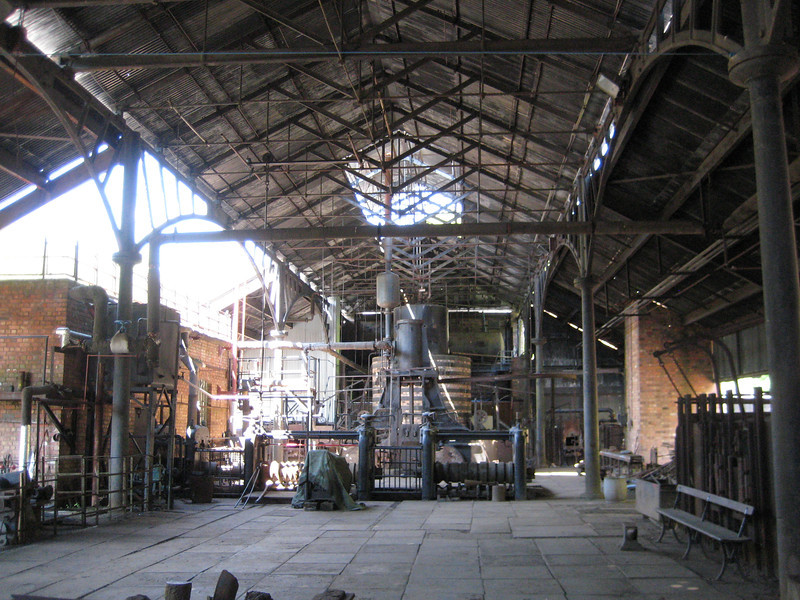 An old iron foundry relocated from Woolwich – you can just see the primitive rolling mill in front of the puddling furnace.
An old iron foundry relocated from Woolwich – you can just see the primitive rolling mill in front of the puddling furnace.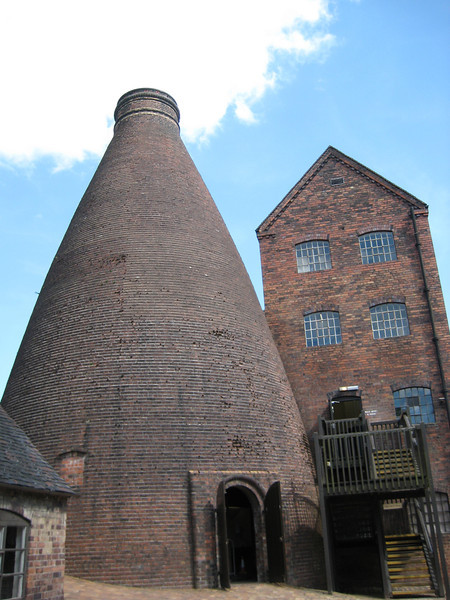 Kiln at the China Museum
Kiln at the China Museum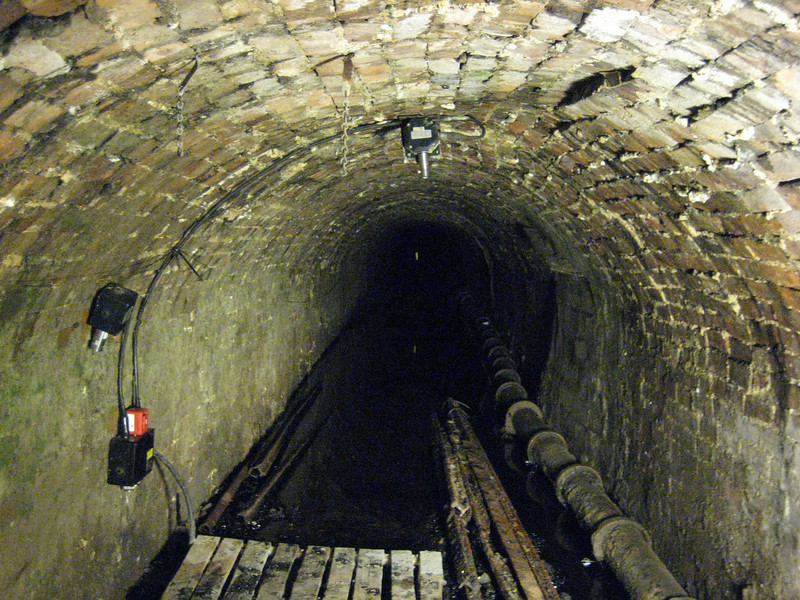 The Tar Tunnel – while trying to open up a transport route between the Shropshire Canal & the Severn, bitumen was discovered.
The Tar Tunnel – while trying to open up a transport route between the Shropshire Canal & the Severn, bitumen was discovered.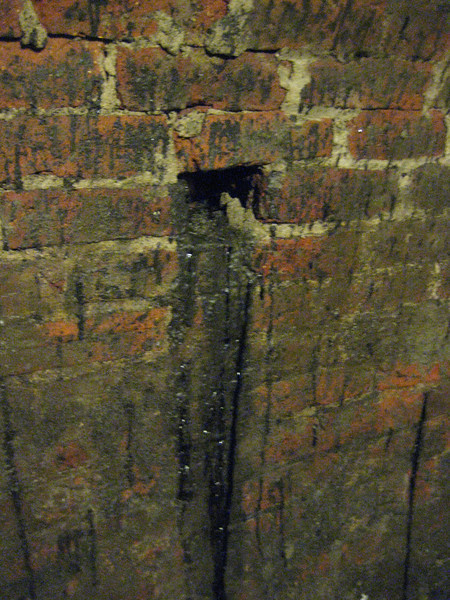 While mostly exploited in the 18th century, some bitumen continues to ooze out of the walls.
While mostly exploited in the 18th century, some bitumen continues to ooze out of the walls.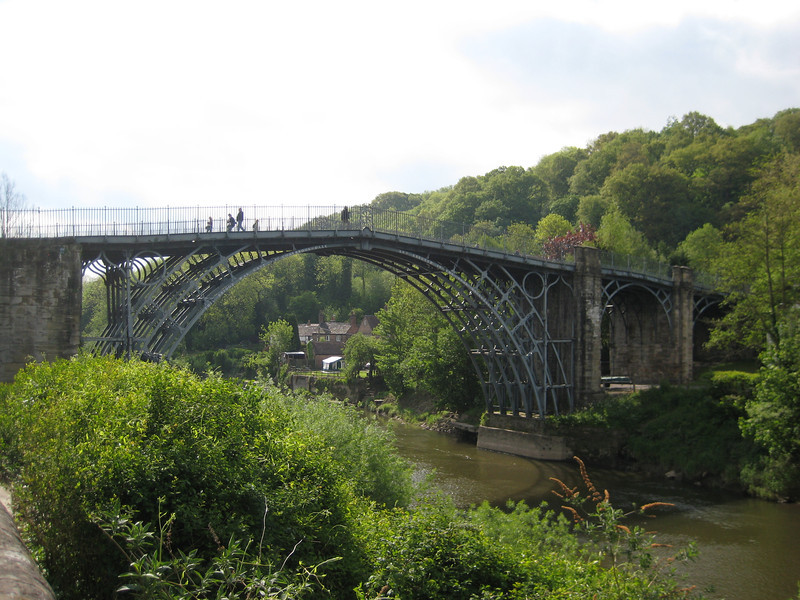
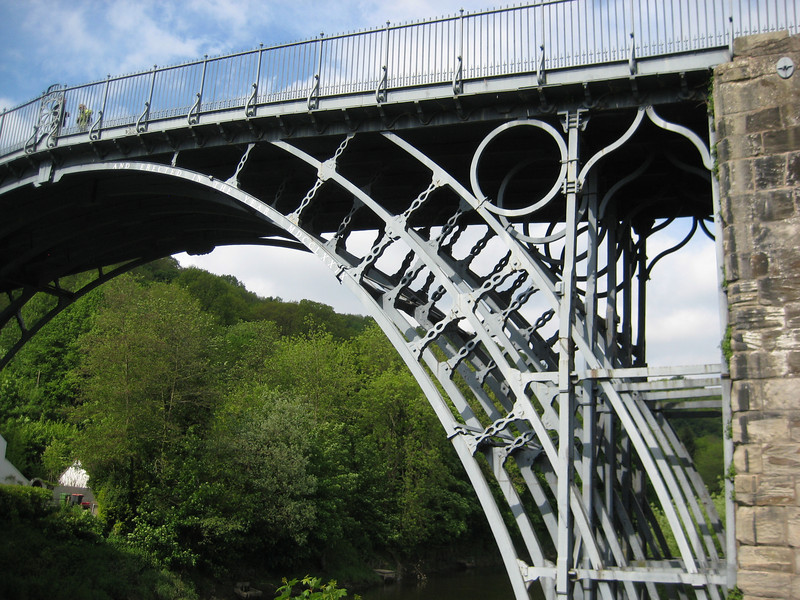
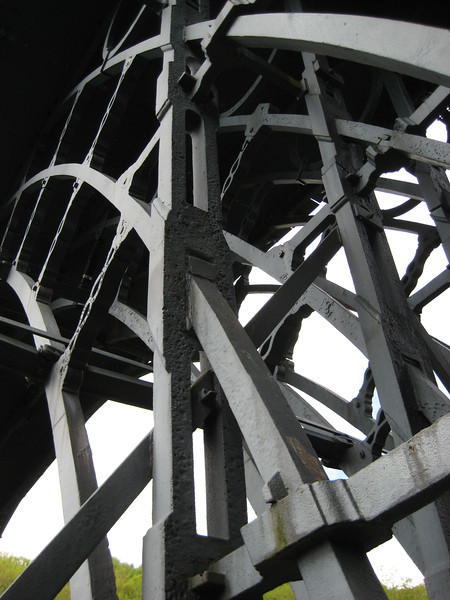
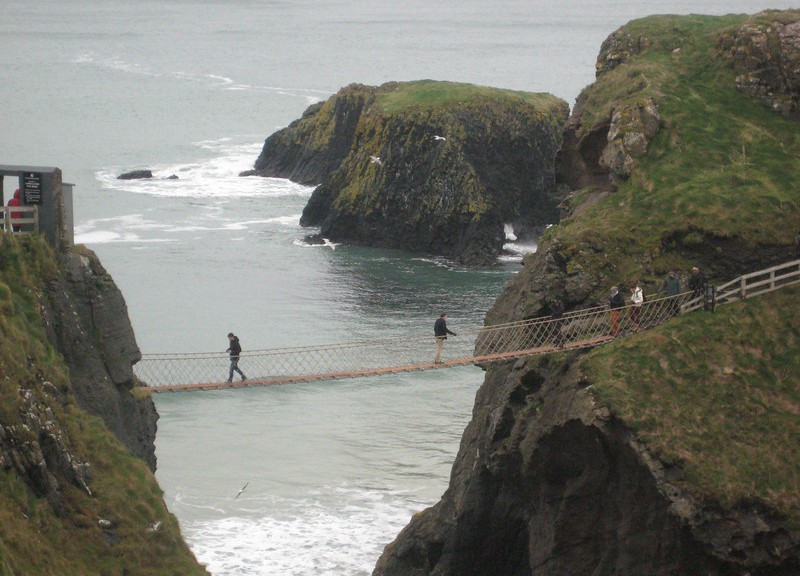
 All that was left standing of the terrace across from the front door – I suspect because this house (the blue bit) had some sort of memorial to a fallen soldier
All that was left standing of the terrace across from the front door – I suspect because this house (the blue bit) had some sort of memorial to a fallen soldier It didn’t get much better across the next street – demolition and breeze-block windowed houses, classy
It didn’t get much better across the next street – demolition and breeze-block windowed houses, classy An old library on the walk to catch the day-trip coach
An old library on the walk to catch the day-trip coach





 Some of the steps suddenly dropped off a few metres – probably good not to get blown over there
Some of the steps suddenly dropped off a few metres – probably good not to get blown over there
 Other people to take photos of me – hoorah!
Other people to take photos of me – hoorah!
 The wind may have got up a bit more
The wind may have got up a bit more

 It’s a striking building
It’s a striking building And there’s a feature wall of steel slab, which of course made me happy
And there’s a feature wall of steel slab, which of course made me happy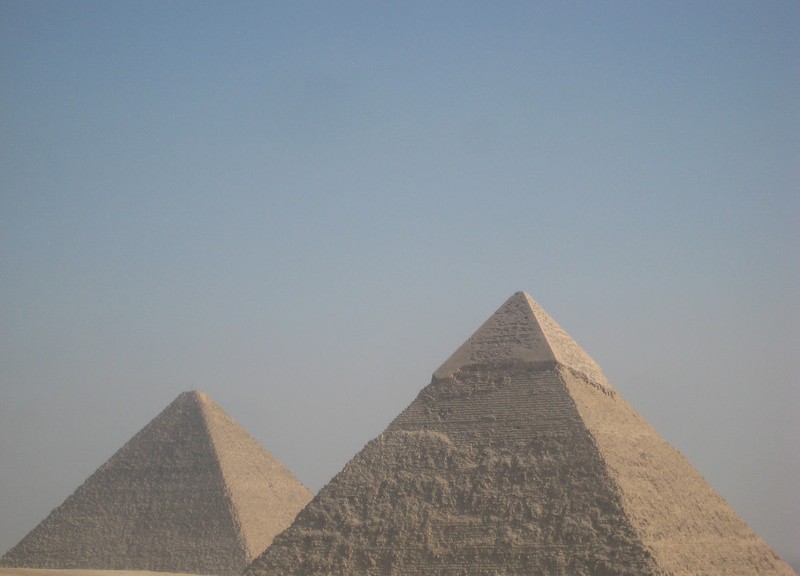
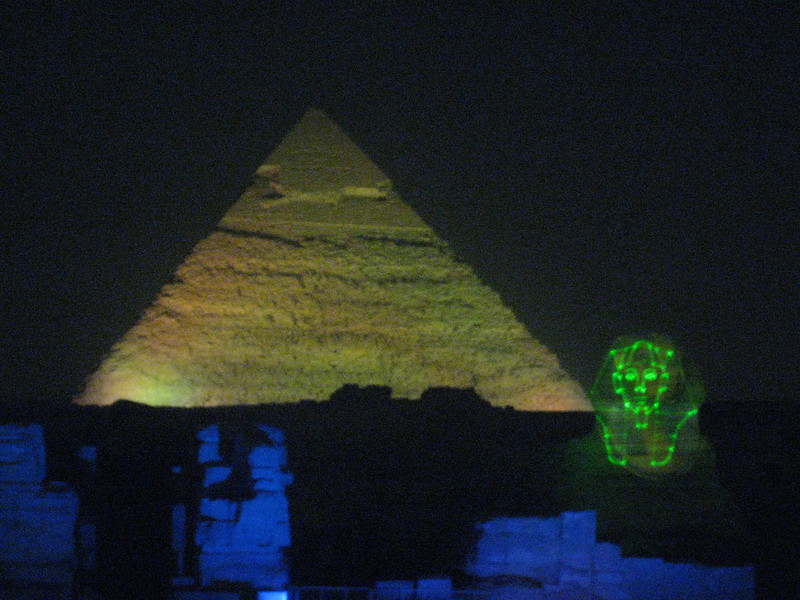
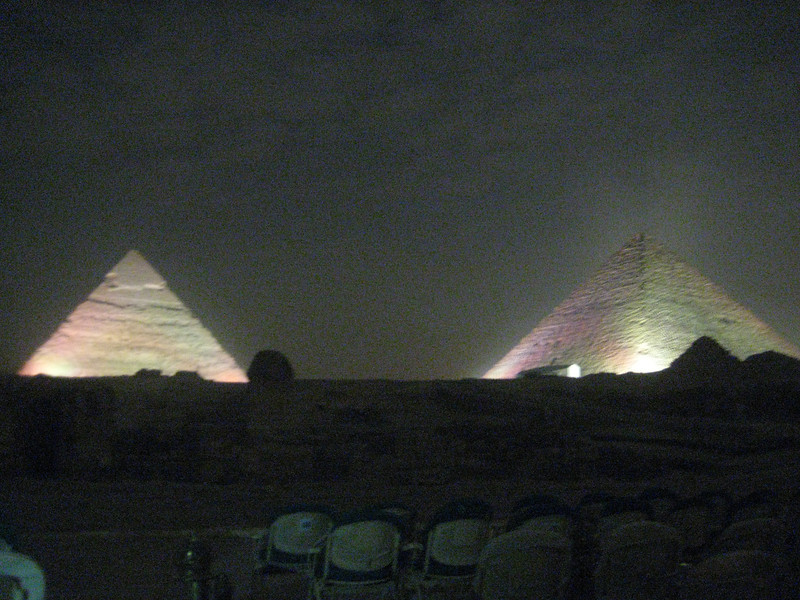
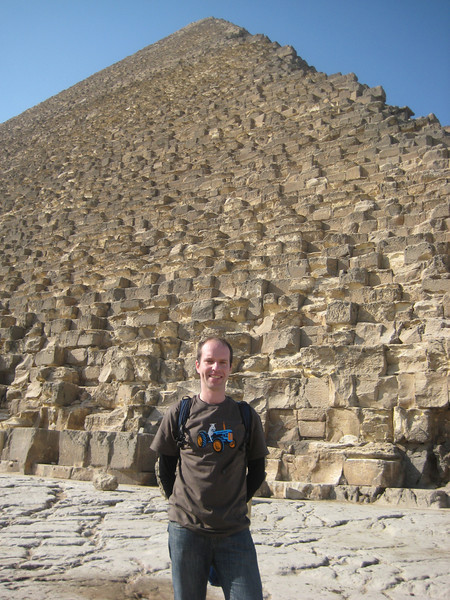 Beside the Great Pyramid/Pyramid of Cheops, mandatory wearing of Christmas presents. Thanks Adele – & yes, that is a sheep driving a Massey Ferguson tractor.
Beside the Great Pyramid/Pyramid of Cheops, mandatory wearing of Christmas presents. Thanks Adele – & yes, that is a sheep driving a Massey Ferguson tractor.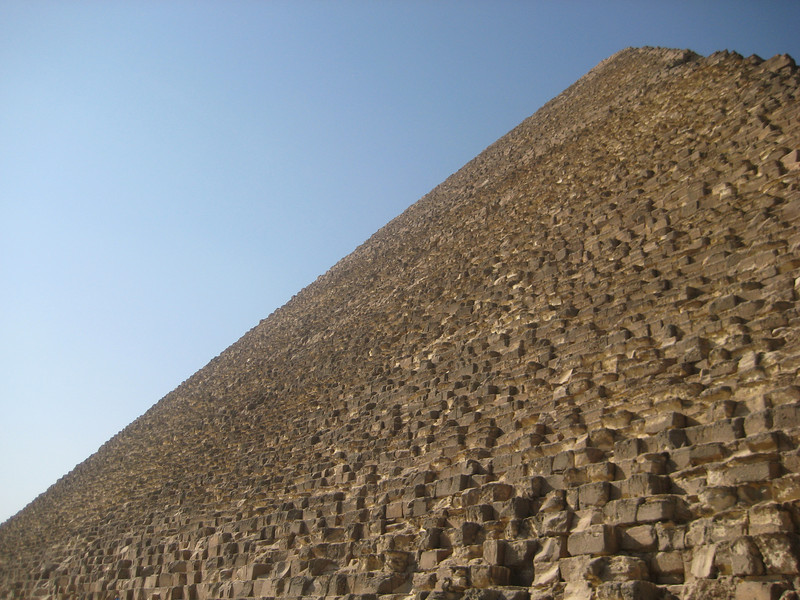
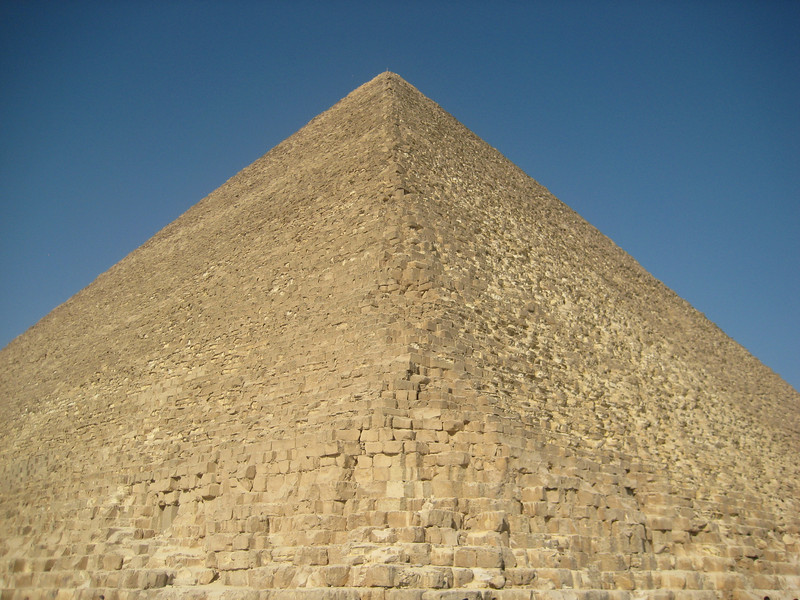
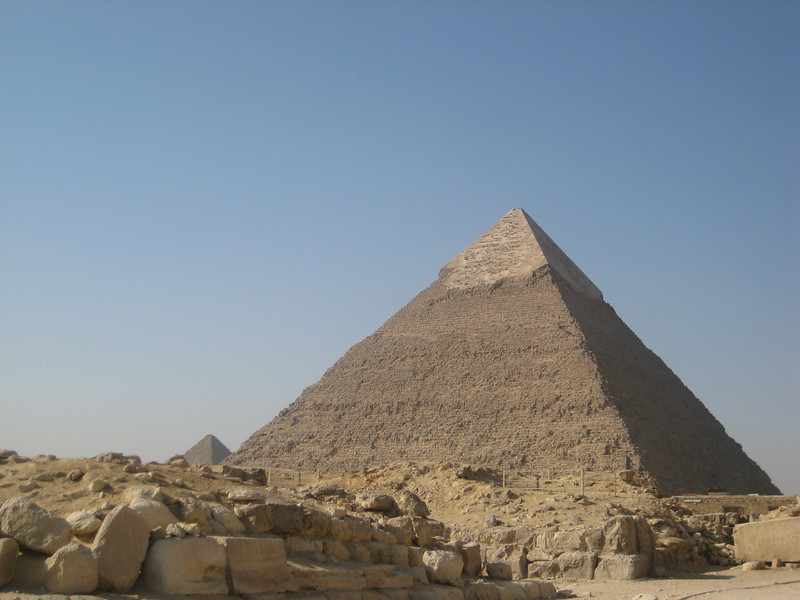 Looking towards the second pyramid, Pyramid of Khafre, which still has some of the smooth outer layer at the peak
Looking towards the second pyramid, Pyramid of Khafre, which still has some of the smooth outer layer at the peak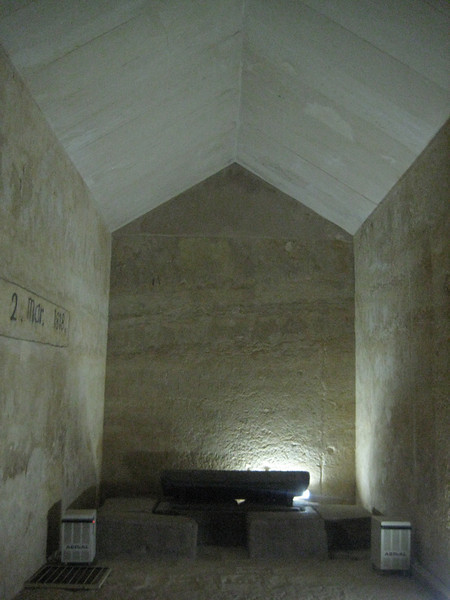 Most of us went down a very steep staircase and then up another to get to the centre of the Pyramid of Khafre. Despite the mildness outside, all that limestone really holds the heat – it was really hot in there
Most of us went down a very steep staircase and then up another to get to the centre of the Pyramid of Khafre. Despite the mildness outside, all that limestone really holds the heat – it was really hot in there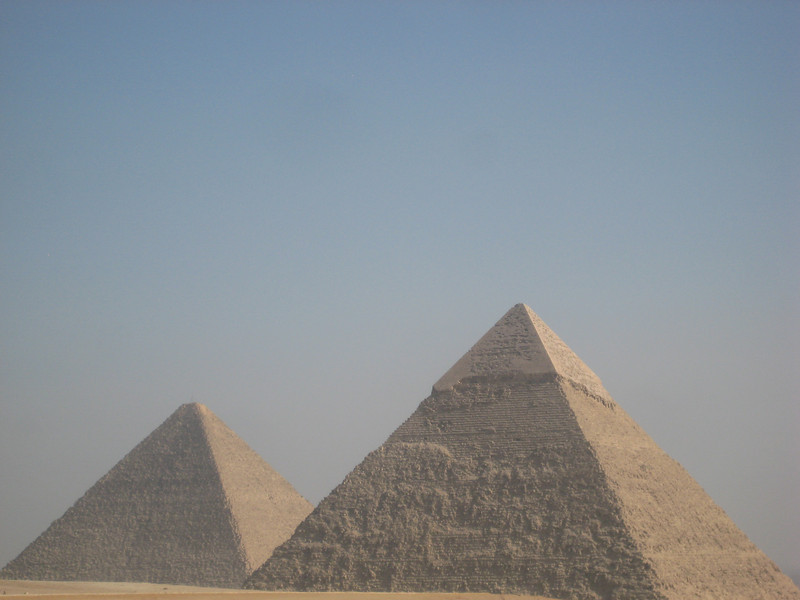 Panoramic photostop
Panoramic photostop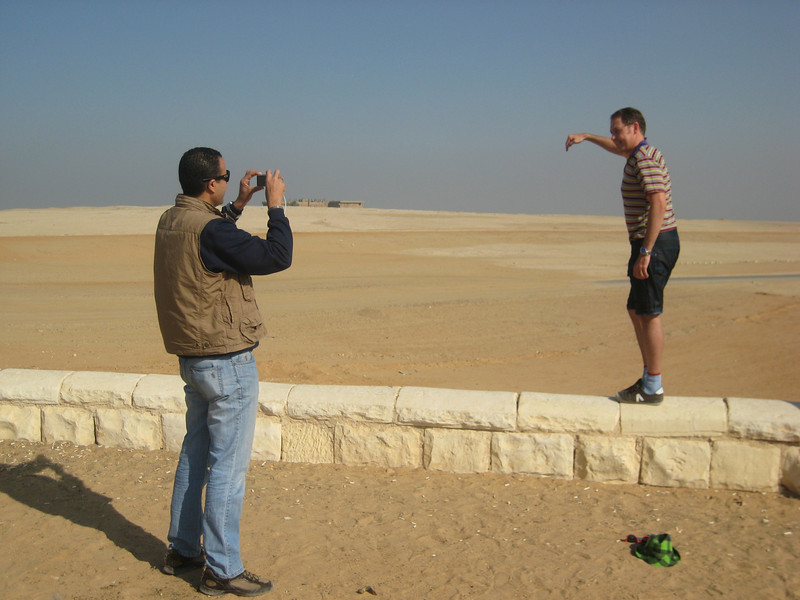 Much time spent holding, pushing, lifting pyramids. Guide Hesham & Radley; unfortunately none of the efforts on my camera really worked out
Much time spent holding, pushing, lifting pyramids. Guide Hesham & Radley; unfortunately none of the efforts on my camera really worked out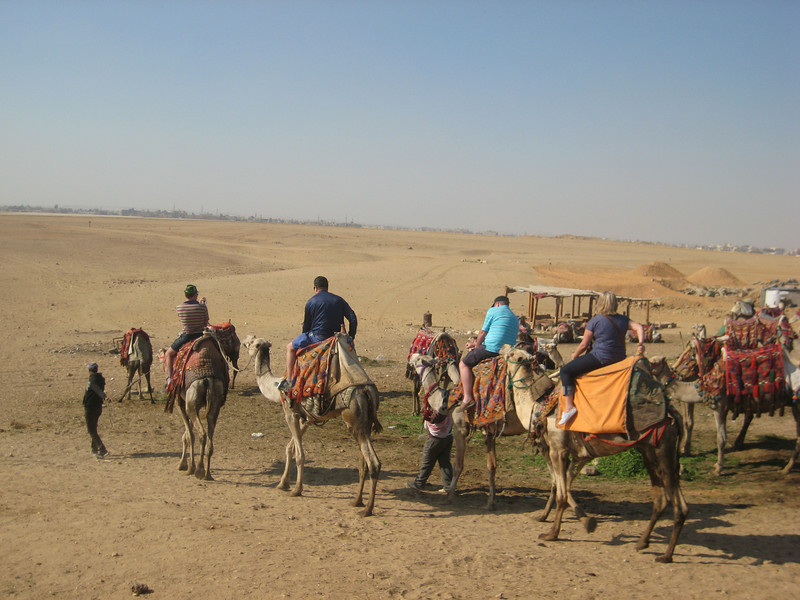 Camel riding – that was a bit of fun for three quid. All the handlers/herders/whatever were good fun & took plenty of photos
Camel riding – that was a bit of fun for three quid. All the handlers/herders/whatever were good fun & took plenty of photos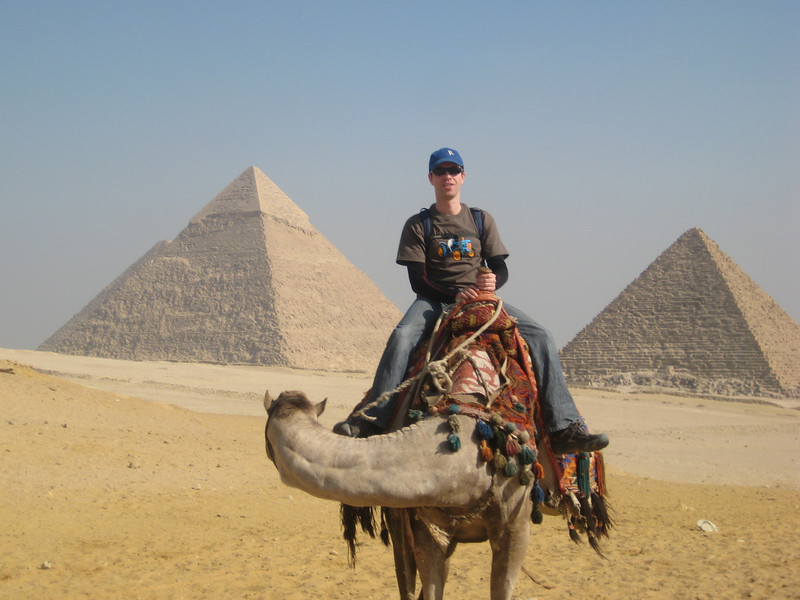
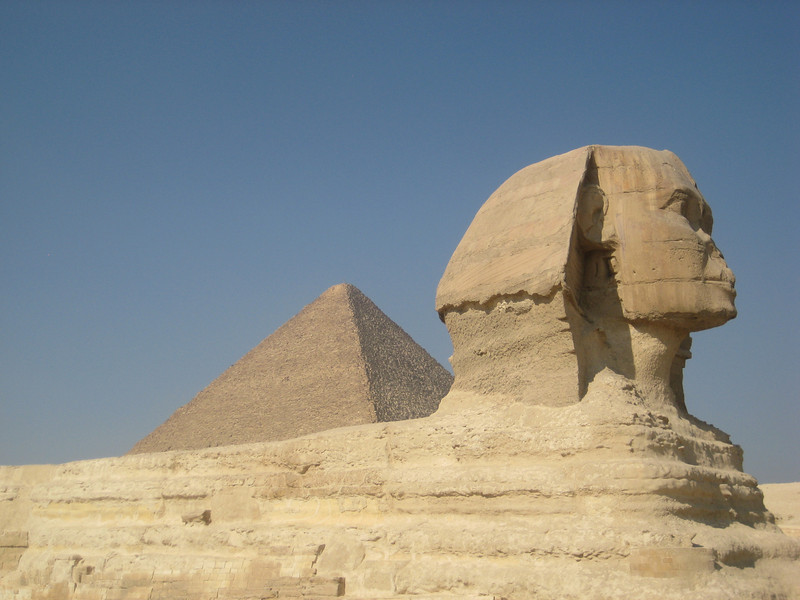 A brief visit to the Sphinx and funerary temple beside it
A brief visit to the Sphinx and funerary temple beside it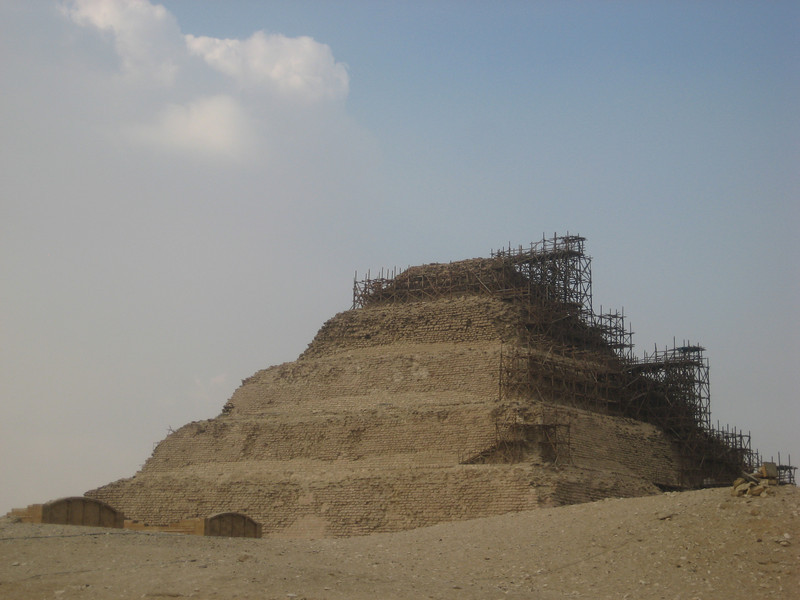 We headed south to see some pyramids earlier in the evolutionary chain, this one a step pyramid and another bent pyramid
We headed south to see some pyramids earlier in the evolutionary chain, this one a step pyramid and another bent pyramid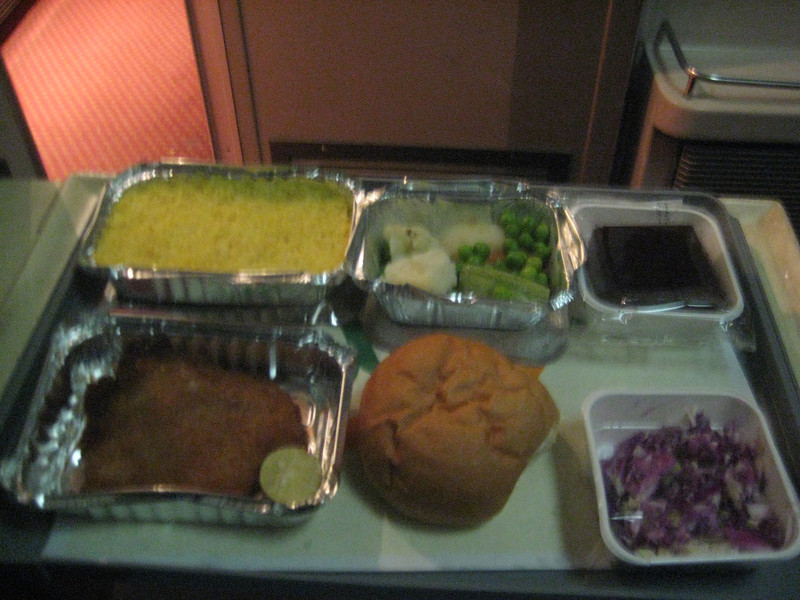 Train food is not all that different to plane food
Train food is not all that different to plane food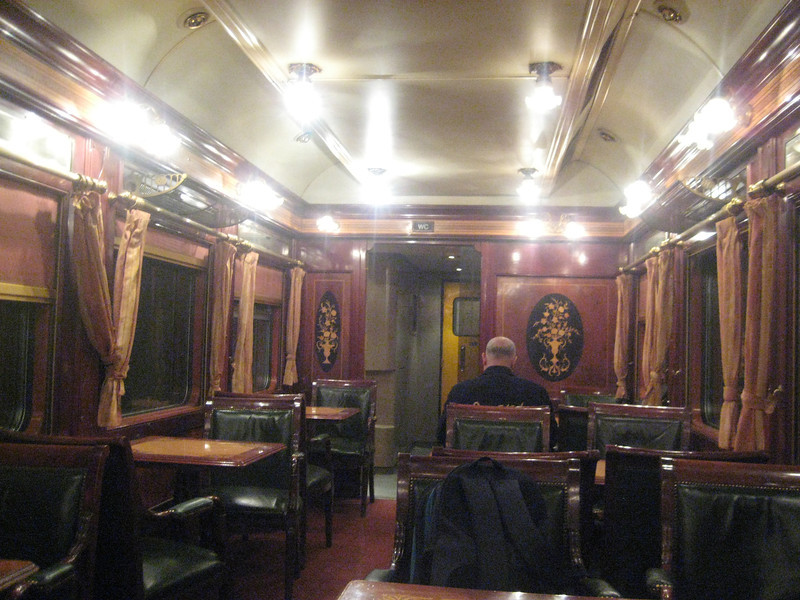 The only part of the train that made me feel like I might be in an Agatha Christie novel
The only part of the train that made me feel like I might be in an Agatha Christie novel